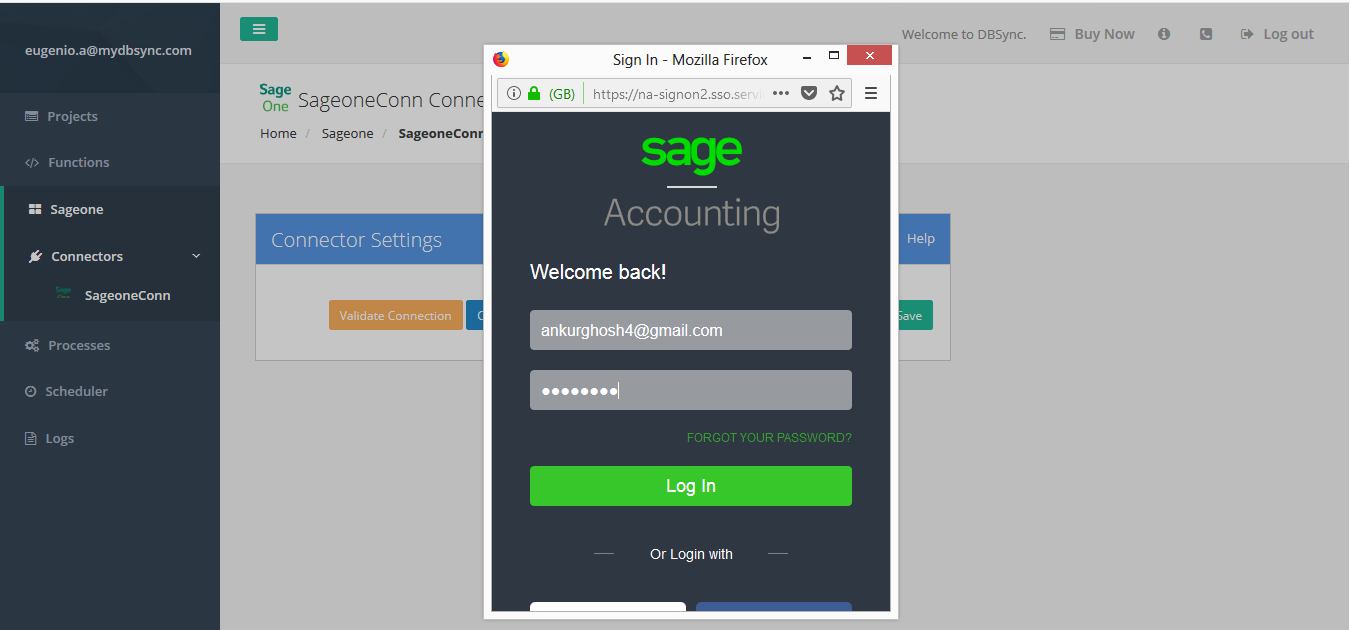2022
Overview
The DBSync's Sageoneconnector is a highly customizable connector that helps you connect your Sageone application with many othe applications, such as MSCRM, Salesforce, SkuVault, and databases. Integration can be done with applications available on the cloud only.
Prerequisites
In order to be able to use the DBSync Sageone connector, the user needs:
- A license for the DBSync Sageone connector. That is, a username and password to connect to DBSync iPaaS platform, and the Sageone connector added to his/her account.
- A valid username and password to connect to Sageone.
- ODBC bridge configured on the server where Sageone sits ( DBSync support team will configure the ODBC bridge for you ).
- Be sure that you have enough privileges in your Sageone account, including the right to create export and import jobs.
Connector Configurations
A Sageone connector instance represents a single Sageone account, including login credentials. If a user wishes to connect to multiple instances of the either sandbox/production, he/she needs to create a separate connection for each of the instances, and configure the ODBC bridge accordingly.
The parameters required to opening the connection to a Sageone user instance are:
| Property | Description | Required |
|---|---|---|
| Username | The username of staging Sage database | yes |
| Password | The password of staging Sage database | yes |
| Base URL | The URL where the Sage staging database is hosted | yes |
After a connector is created within a project, set up the connector within the process, DBSync can map to and from many systems using the Sageone connector to retrieve data from or send data to Sageone Accounting application.Click on the following link to know which all connectors we support Connectors List .
Sageone Supported Operations
Note : {Key} specifies Id of the respective record in Sageone.
| Operation | Use |
|---|---|
| ledger_accounts | Get ledger account Ids |
| tax_rates | Get tax rate Ids |
| contact_persons | Add new Contact Persons |
| contact_persons/{key} | Update Contact Persons |
| contacts | Add new Contacts |
| contacts/{key} | Update Contacts |
| products | Add new products |
| products/{key} | Update Products |
| sales_invoices | Add new Invoices |
| sales_invoices/{key} | Update invoices |
purchase_invoices | Add new purchase invoice |
| sales_quotes | Add new Quotes |
| sales_estimate | Add new estimates |
| stock_movements | Inventory adjustment |
| services | Insert Services |
Uses Of Sageone Connector
The following are the few uses of our Sageone connector.
- Eliminate manual data entry by connecting Sageone to other CRM or Accounting or Order management system, which is supported by us.
- Automate business process to increase efficiency across departments by reducing data reconciliation
- Make your customer, item, vendor, sales rep, invoice, invoice history, sales order records as zero error prone while moving in and out of Sageone.
Supported Versions
Frequently Asked Questions
Q: Does DBSync need to be installed on the same machine as that of Sage 100?
A: DBSync Sageone connector can be either configured on the same instance where Sageone is installed or on a remote machine which can access Sage 100 database.
Q: What are the limitations of DBSync integration with Sageone?
A: There is no real-time integration of data directly from Sageone to target systems/ application due to the rule imposed by Sage 100 itself, whenever there is import or export of data from Sage 100 then it should happen through visual integrator as Sageone do not expose Apis / web-service for consumption by other applications.
Q: How does DBSync connect to Sageone?
A: DBSync connects to Sageone through Visual Integrator provided by Sageone to read data from and write data out of the Sageone application.
